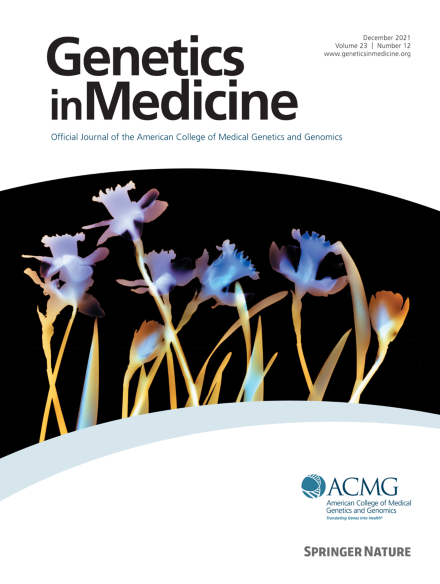PTEN错构瘤肿瘤综合征(PHTS)发生第二原发癌的风险。
IF 6.2
1区 医学
Q1 GENETICS & HEREDITY
引用次数: 0
摘要
目的:PTEN错构瘤肿瘤综合征(PHTS)患者具有较高的遗传性乳腺癌、子宫内膜癌和甲状腺癌风险。患者会发生多种原发癌症,但这些风险仍不确定。我们的目标是提供第二个原发癌症风险。方法:这项欧洲队列研究使用来自医疗档案和/或登记处的数据,通过Kaplan-Meier分析评估了第二原发癌症的风险。结果:总共纳入279例成年PHTS伴癌患者(80%为女性)。在女性中,112例(54%)在phts相关的第一原发性癌症后发生了phts相关的第二原发性癌症,而11例(30%)男性在phts相关的第一原发性癌症后发生了phts相关的第二原发性癌症。5年和10年与phts相关的第二原发癌风险女性分别为23% (95%CI=16-31)和46% (95%CI=37-56),男性分别为18% (95%CI=8-38)和23% (95%CI=11-45)。此外,第一次原发性乳腺癌后5年和10年发生第二次原发性乳腺癌的风险分别为23% (95%CI=15-35)和46% (95%CI=33-60)。结论:本研究表明PHTS患者具有较高的第二原发癌风险,这是由女性乳腺癌驱动的。因此,在首次原发性癌症诊断之前或在首次原发性癌症诊断时识别PHTS患者对于通过监测或降低风险的手术实现潜在的早期发现或预防第二原发性癌症至关重要。本文章由计算机程序翻译,如有差异,请以英文原文为准。
The risk of a second primary cancer in PTEN Hamartoma Tumor Syndrome (PHTS)
Purpose
Patients with PTEN Hamartoma Tumor Syndrome (PHTS) have high hereditary cancer risks for breast, endometrial, and thyroid cancer. Patients develop multiple primary cancers, but these risks remain uncertain. We aimed to provide the second primary cancer risk.
Methods
This European cohort study assessed second primary cancer risks with Kaplan-Meier analyses using data from medical files, registries and/or patient questionnaires.
Results
Overall, 279 adult PHTS patients with (a history of) cancer were included (80% female). Among females, 106 (54%) developed a PHTS-related second primary cancer after a PHTS-related first primary cancer, whereas 10 (29%) males developed a PHTS-related second primary cancer after a PHTS-related first primary cancer. The 5- and 10-year PHTS-related second primary cancer risks were 24.5% (95% CI = 18.1-32.5) and 45.7% (95% CI = 36.9-55.4) in females and 14.5% (95% CI = 5.7-34.1) and 19.8% (95% CI = 8.6-41.9) in males, respectively. Furthermore, 5- and 10-year risks for a second primary breast cancer after a first primary breast cancer were 23.3% (95% CI = 14.9-35.2) and 45.6% (95% CI = 33.0-60.2) in females, respectively.
Conclusion
This study demonstrated that PHTS patients have high second primary cancer risks, which is driven by breast cancer in females. Hence, identifying patients with PHTS before or at first primary cancer diagnosis is essential to enable potential early detection or prevention of a second primary cancer through surveillance or risk-reducing surgery.
求助全文
通过发布文献求助,成功后即可免费获取论文全文。
去求助
来源期刊

Genetics in Medicine
医学-遗传学
CiteScore
15.20
自引率
6.80%
发文量
857
审稿时长
1.3 weeks
期刊介绍:
Genetics in Medicine (GIM) is the official journal of the American College of Medical Genetics and Genomics. The journal''s mission is to enhance the knowledge, understanding, and practice of medical genetics and genomics through publications in clinical and laboratory genetics and genomics, including ethical, legal, and social issues as well as public health.
GIM encourages research that combats racism, includes diverse populations and is written by authors from diverse and underrepresented backgrounds.
 求助内容:
求助内容: 应助结果提醒方式:
应助结果提醒方式:


